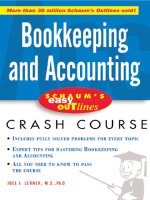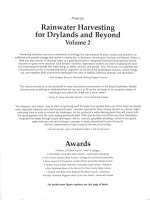Bookkeeping and accounting volume 2 by JAMES o McKINSEY
Bạn đang xem bản rút gọn của tài liệu. Xem và tải ngay bản đầy đủ của tài liệu tại đây (31.44 MB, 604 trang )
VOLUHE
II
Series
A
Digitized by the Internet Archive
in
2007 with funding from
Microsoft Corporation
/>
OKKEEPING AND
ACCOUNTING
ft
Bt
JAMES
Member of
the
O.
McKINSEY, A.M., C.P.A.
firm of Frazer
Assistant Professor
&
Torbet,
Certified Public Accountants;
of Accounting, University of Chicago
VOLUME
II
n
.<*
Published by
South-Western Publishing Company
CINCINNATI, OHIO
**
Copyright, 1921
SOUTH-WESTERN PUBLISHING COMPANY
Cincinnati, Ohio
PREFACE
The subject matter of this text may be divided broadly into
two parts. The first twelve chapters deal with the general principles governing the construction and use of reports, accounts and
records. In these chapters the accounts and records of a corporation and the accounts of a manufacturing business are given
particular attention.
Some
attention
is
given to the problem of
depreciation and to the technical phases of account keeping as
Chapter XLVIII
on the subject matter of Chapters XXXVI to XL VII
and a thorough review in the application of general accounting
illustrated in special types of ledger records.
affords a drill
principles.
The last twenty-four chapters deal primarily with the use of
accounting in the control of the relations which the business unit
must have with those both external and internal to its organization.
The purpose and aim of these chapters is fully set forth
in Chapter XLIX on "The Relation of Accounting to Business
Management."
Chapters
L
to
LV
deal with the construction and interpretation
which are used by business
and governmental agencies in
judging the financial condition of a business at a specific time and
Chapters LVI and
its progress during a specific period of time.
LVII explain the construction and interpretation of financial
statements other than the Balance Sheet and Statement of Profit
and Loss of an industrial or commercial firm. Chapters LVIII to
LXV treat of records and reports used in the control and management of the operations of the functional departments of a busiof the orthodox financial statements
executives, stockholders, creditors
LXVI
deals with accounting for the investments
Chapters LXV II to LXXII deal with the
accounting organization and procedure by which the information
discussed in the preceding chapters is collected, organized, classi'
fied and presented for executive use.
There is much material included in this text which is not ordiThis
narily included in a text on bookkeeping and accounting.
ness.
Chapter
in other companies.
Preface
introduced to give the student sufficient information with
management to enable him to
understand how accounting may be used in their solution.
material
is
reference to the problems of business
Throughout the text the student
taught to look at the accounting
is
records from the viewpoint of the manager, rather than from the
viewpoint of the bookkeeper.
This not only enables him to con-
struct the records so that they will be most useful to the manager,
but also gives him a training which will
a managerial position.
The text material
is
assist
him
to
advance to
divided into distinct chapters, each chapEach chapter consists of
ter dealing with one principal topic.
three parts:
1.
A
discussion of the accounting principles which
relate to the topic of the chapter.
2.
class
A
series
of questions
and short problems for
and apply the prin-
discussion which develop
ciples discussed in the chapter.
These questions are
primarily "thought" questions which develop the stu-
dents' ability to analyze and interpret business and
accounting statistics.
3. Laboratory exercises and problems which
illus-
and require the application of the principles
Although most of the
discussed in each chapter.
laboratory material consists of short exercises which
illustrate specific principles and minimize detail, there
Chapter XLVIII which
is given one complete "set"
covers a fiscal period of two months and affords the
student an acquaintance with the bookkeeping system
trate
—
—
as a whole.
The material
is
especially adapted to instruction
by the
class
been arranged so that class assignments
can be made and recitation based on these assignments conducted.
The author is indebted to many teachers, accountants and business men for assistance and helpful suggestions in connection with
the preparation of the manuscript. Among those to whom he is
especially indebted are the following: Homer N. Sweet, C. P. A.
of the firm of Lyrand, Ross Brothers, and Montgomery who
provided some of the subject matter of Chapter LXII on "Records
and Reports for the Purchasing Department"; A. O. Brungardt,
Assistant Works Manager, Boston Factory, Walworth Manufactur-
recitation method.
It has
Preface
ing
Company who
assisted in the preparation
of
Chapters
LX
and LXI on the "Records and Reports of the Production Department"; W. H. Spencer, Assistant Professor of Business Law,
University of Chicago,
who read
the chapters dealing with corpo-
ration organization and accounting; L.
S.
Lyon, Assistant Pro-
fessor of Business Organization, University of Chicago,
and
P. E.
Schenley High School, Pittsburgh, Pennsylvania,
who read all the manuscript and gave many helpful suggestions;
Glen S. Griffin, who rendered valuable assistance in the preparation of the Laboratory Material in Chapter XL VIII and Miss May
R. Freedman, the author's secretary, who rendered valuable assistance in many ways in the preparation of the manuscript.
Special acknowledgement is due to Mr. Earl W. Barnhart,
Chief of the Commercial Section, Federal Board of Vocational
Education, Washington, D. C, who is the author of Chapters
LXIX and LXX on "Mechanical Accounting."
Curry of the
;
James
New York
n-A
City,
June
1,
1921
0.
McKinsey
CONTENTS
Chapter XXXVII. Nature and Characteristics
Need for Considering the Corporate Form
The Corporation Defined
Comparison of Corporation and Partnership
of the Corporation
Advantages of the Corporate Form
Disadvantages of the Corporate Form
Working Organization of the Corporation
Relation of Accounting to the Corporate Form
Chapter XXXVIII.
Proprietorship in the Corporation
Proprietorship Vested in Stockholders
Proprietorship of Corporation Divided into Shares
Ownership Evidenced by Stock Certificates
Classification of Stock
Method of Showing Proprietorship on the Balance Sheet
Value of Stock
Chapter XXXIX. Formation and Operation of a Corporation
Formation of a Corporation
Certificate of Incorporation
Opening Entries
Changing from a Partnership to a Corporation
Operations of a Corporation
Chapter XL.
Accounts Peculiar to a Corporation
Capital Stock, Capital and Surplus
Accounts with Capital Stock
Surplus Account
Dividend Account
Treasury Stock Account
Accounts with Subscriptions. Receivable and Capital Stock Subscribed
Chapter XLI. Records Peculiar to a Corporation
Records Required by a Corporation
Minute Book
Subscription Book
Subscribers Ledger
Stock Certificate Book
Stock Ledger
Stock Transfer Book
Chapter XLII.
^orm and Content
The Balance Sheet
of the Balance Sheet
Showing Proprietorship on the Corporation Balance Sheet
Asset and Liability Items on the Corporation Balance Sheet
Fixed Assets
Intangible Assets
Long-Term or Fixed Liabilities
Effect of Manufacturing Operations on the Balance Sheet
Chapter XLIII.
The Statement
of Profit
and Loss
Relation of the Statement of Profit and Loss to the Balance Sheet
Form of the Statement of Profit and Loss
Statement of Profit and Loss for Different Types of Industries
Statement of Profit and Loss for a Manufacturing Business
Simplification of Statement of Profit and Loss by Use- of Schedules
Schedule of Cost of Goods Sold
Other Schedules
A-n
rii
Contents
viii
Chapter XLIV.
Construction and Interpretation of Particular Accounts
Accounts with Fixed Assets
Charges to Capital versus Charges to Revenue
Intangible Assets
Fixed or Long-Term Liabilities
Mortgages Payable
Bonds Payable
Long-Term Notes
Accounts Showing Cost of Goods Manufactured
Materials Account
Labor Account
Manufacturing Expense
Materials in Process
Manufacturing Account
Finished Goods Account
Cost of Sales Account
Trading Account
Chapter
XLV. Records
of Original
Entry
Relation of Records of Original Entry to Operations of the Business
Columnar General Journal
Journal Vouchers
Voucher System
Voucher Register
Relation of the Voucher System to Accounts Payable Ledger
Card Record of Vouchers Payable
Cash Records
Sales Record
Notes Receivable and Notes Payable Journals
Chapter
XL VI.
Different
Types
of Ledgers
Causes of Different Types
Relation of General Ledger to Subsidiary Ledger
Private Ledger
Relation of General and Private Ledger
Classification of Ledgers as to Ruling
Standard Ruling
Balance Ruling
Progressive Ruling
Miscellaneous Ruling
Classification of Ledgers According to Binding
Bound Ledger
Loose-Leaf Ledger
Card Ledger
Method of Classifying and Indexing Card Ledgers
Method of Filing Ledger Cards
Chapter
XL VII.
Depreciation
Nature of Depreciation
Causes of Depreciation
Method of Calculating Depreciation
Method of Showing Depreciation on Reports
Method of Recording Depreciation in the Accounts
Operation of the Reserve for Depreciation Account
Plant Ledger
Chapter XLVTJI.
A
Practice Set
A-n
The Applications
of the Principles
,
.
Contents
Chapter XLIX.
Basis of Business
ix
Relation of Accounting to Business
Management
Management
Method by which Accounting and Statistical Data is Obtained
Nature of Reports Required
Parties Interested in Accounting and Statistical Reports
Classification of Reports Used in Administration
Need for Estimates
Chapter L.
The Standard Form
of Balance Sheet
The Standard Balance Sheet
The Use of the Standard Form of the Balance Sheet
Balance Sheet Desired by Long-Time Creditors
Balance Sheet Desired by Short-Time Creditors
Balance Sheet Desired by Governmental Agencies
Balance Sheet Desired by Stockholders
Reason for General Use of Standard Type of Balance Sheet
The Standard Form of Balance Sheet
Notes and Accounts Receivable
Securities
Bills,
Notes and Accounts Pavable
Net Worth
Chapter LI.
The Standard Form
of
Statement of Profit and Loss
Standardization of the Statement of Profit and Loss
Statement of Profit and Loss Usually Condensed
The Standard Form of Statement of Profit and Loss
Standard Form of Statement of Profit and Loss Recommended by the Federal
Reserve Board
Summary
Chapter LII.
Analysis of Financial Statements
Basis for the Interpretation and Use of Financial Statements
The Balance Sheet
Current Assets
Fixed Assets
Chapter LIII.
—Continued
Analysis of Financial Statements
Notes Payable
Accounts Payable
Accrued Liabilities
Bonds Payable
Mortgages Payable
Contingent Liabilities
Capital
Reserves
The Statement
of Profit
and Loss
Sales
Cost of Goods Sold
Operating Expenses
Other Income
Other Expenses
Chapter LIV.
The Value
—Continued
Analysis of Financial Statements
of Comparisons
Classification of Possible Comparisons
Comparison of Items on a Particular Balance Sheet
Comparison of Corresponding Items and Ratios on Different Balance Sheets
A-n
Contents
x
—
Chapter LV. Analysis of Financial Statements Concluded
Comparison of Items on a Particular Statement of Profit and Loss
Comparison of Corresponding Items and Ratios on Different Statements of Profit
and Loss
Omissions
Relation of Comparative Balance Sheet to Comparative Statement of Profit
and Loss
Summary
Chapter LVI. Different Types of Financial Statements
The "Statement of Condition" of a Bank
The Standard Form of Bank Statement
Illustration of Bank Statement with Explanation of Asset and Liability Items
Discussion of Particular Items of Bank Statement
A Novel Form of Bank Statement
Chapter LVTI.
The Statement
Different
Types
of Financial
Statements
—Continued
of Affairs
Illustration of the Statement of Affairs
The Deficiency Statement
Balance Sheet for a Professional Association
The English Balance Sheet
The Statement of Earnings of a Bank
Statement of Income and Expense of a Professional Association
Statement of Income and Expense for a Professional Firm
Statistical Reports
Chapter LVIII. Records and Reports for the Sales Department
Importance of Sales Information
The Functions of the Sales Department
The Organization of the Sales Department
Data
Commodity or Departmental Analysis
Analysis by Selling Units
Analysis by Territories
Analysis by Salesmen
Analysis by Terms of Sale
Analysis by Method of Delivery
Classification of Sales
Relation of the Sales Analysis to the Accounting Records
Analysis of Sales Returns and Allowances
Chapter LIX.
Record and Reports for the Sales Department
—Continued
Different Kinds of Sales
Sales on Account
Cash Sales
C. O. D. Sales
Installment Sales
Sales on Approval
Sales for Future Delivery
Branch Sales
Planning Future Sales
Sales Reports
Chapter LX. Records and Reports for the Production Department
The Production Problem
Functions of the Production Department
Organization of the Production Department
Control of Inventories
Inventory Records
Establishment of Maximum,
Minimum and Quantities to Order
Enforcement of Minimum and Quantities to Order
Balance of Stores for
A-n
Raw
Materials
Contents
Chapter LXI.
Records and Reports for the Production Department
xi
—Continued
The Planning of Production
The Notice of Minimum
Production Order
Bill of Materials
Balance of Stores for Raw Materials
Materials Requisition
Labor Tickets
Assembling of Time Tickets
Finished Goo'ds Report
Cost Accounting Records
Manufacturing Expense
Apportionment of Manufacturing Expenses
Labor Percentage Rate
The Labor Hour Rate
Production Center Rate
Departmental Classification of Manufacturing Expenses
The Cost Entries
Methods of Cost Finding
Summary
Chapter LXII.
Records and Reports for the Purchasing Department
Relation of Purchase Procedure to Accounting
The Functions of the Purchasing Department
Organization of the Purchasing Department
Purchase Forms
The Purchase Requisition
The Purchase Order
The Purchase Invoice
Other Purchase Forms
Purchases Records
Classification of Purchases
Method
of Showing Classification of Purchases
Classification of Unfilled Orders
Planning of Purchases
Purchase Reports
Chapter LXIII.
Records and Reports for Branches
Reasons for Establishing Branches
Organization for Branch House Control
Methods of Branch Accounting Control
Cash
Purchases
Sales
Expenses
Accounts Receivable
Accounts Payable
Branch House Reports
Monthly Balance Sheet
Statement of Profit and Loss
Monthly Expense Analysis
Monthly Inventory Report
Chapter LXIV.
Records and Reports for the Credit Department
The Credit Problem
The Functions of the Credit Department
The Organization of the Credit Department
Granting of Credit
Handling of Collections
Credit Reports
A.-n
Contents
xii
Chapter LXV.
Records and Reports for the Financial Department
Relation of the Financial Department to the Other Departments
Functions of the Financial Department
Organization of the Financial Department
Handling the Cash Receipts
Handling the Cash Disbursements
Determination of Financial Requirements
Financial Reports
Reports to the Treasurer
Chapter LXVI.
Meaning and Purpose
Accounting for Investments
of Investments
Classification of Investments
Accounting for Stocks
Accounting for Bonds
Premium and Discount on Bonds Issued
Accrued Interest on Bonds
Investment in Fixed Assets
Chapter LXVII.
The
Periodical
Summary
Purpose of the Periodical SummaryPeriodical Adjustment of the Accounts
Loss on Bad Debts
Depreciation on Fixed Assets
Accrued Income
Accrued Expense
Deferred Charges to Expense
Deferred Credits to Income
Periodical Closing of the Accounts
Post-Closing Entries
Disposition of Net Profit
Chapter LXVTII.
Records of Entry
Classification of Accounting Records
Auxiliary Records
Records of Original Entry
Development of Journalization
Development of Special Columns
Loose-Leaf and Card Records
Records of Final Entry
Review and Summary
in Separate Journals
Chapter LXIX.
Mechanical Accounting
The Meaning
Why
of "Mechanical Accounting"
Machines are Used
Errors in Mechanical Accounting
are Used
Purposes for which Machines are Used
What Machines
Adding Machines
Calculating and Computing Machines
Preparation of Statements
Preparation of Accounting Records
Simple Ledger Posting
Unit Posting Media
How
Mechanical Posting Saves Time
Contents
Chapter LXX.
xiii
Mechanical Accounting
—Continued
Balance Ledger Posting
Proving Balance Ledger Posting
Control in Mechanical Posting
Summary of Accounts Receivable Control
Statistical Analysis
Equipment Necessary for Tabulating Work
Tabulating Card
The Key Punch
The Sorter
The Tabulator
Analysis for which Tabulating Machines are Used
Advantages of Tabulating Equipment
Chapter LXXI.
Organization for Accounting Control
Need for Accounting Organization
The Accounting Organization
The Duties of the Comptroller
The Staff of the Comptroller
.
.
Relation of the Comptroller to the General Auditor
The General Auditor
General Office Accounting Section
Branch and Intercompany Accounting Section
Cost Accounting Section
Tabulating Section
The Payroll Section
Accounts Payable Section
Accounts Receivable Section
Billing Section
The Interrelation of Sections
Chapter LXXII.
Relation of Auditing to Accounting
The Purpose of an Audit
Kinds of Audits
Responsibility for Auditing
The Professional Auditor and Accountant
The Certified Public Accountant
Auditing Procedure
The Auditor's Report
The Auditor's
A-n
Certificate
Auditing
CHAPTER XXXVII
THE NATURE AND CHARACTERISTICS OF THE
CORPORATION
Need for Consideration
From
counting
Form
of the Corporate
the viewpoint of this text the primary purpose of acis to
provide information which will serve as a basis for
The management of a business is dependent
business management.
on
owners or those to whom they have delegated their authorThe ownership of a business may be vested in a sole proprietor-
its
ity.
ship,
a partnership,
or a corporation.
In previous chapters the
nature and characteristics of the sole proprietorship and of the
partnership have been explained.
It is now necessary to consider the nature
and characteristics of a corporation and
the additional information which
this
is
to see
necessary for control under
type of organization.
During the past few years the study of the corporate form of
organization has become of increasing importance because of the
rapidly increasing number of businesses which are owned and
controlled by the corporate form of proprietorship. "With the enlargement of the scale upon which business is conducted, there has
come a demand for such a quantity of capital as can be obtained
only by securing contributions from many investors. In order to
obtain the desired number of investors, it is necessary to secure
the investment of many who have accumulated savings.
These
investors desire to secure an income from the use of their savings,
but desire to avoid being burdened with the active duties of management and to limit their liability for loss at least to the amount
of their investment.
The corporate form of business organization
satisfies these
demands, and, as a
result,
has secured for
itself
a
and industrial enterprises.
The corporation marks a decided improvement over the
partnership as an agency for furthering large-scale industry. Consequently, today it represents the most advanced stage of business
organization.
It is quite important and necessary, therefore, for
firm footing in the conduct of commercial
the student of accounting to acquaint himself with
its
character505
Bookkeeping and Accounting
506
istics
and working
purpose
of
the
plans.
present
To explain and illustrate these is the
chapter and the chapters immediately
following.
The Corporation Defined
Chief Justice Marshall in the well-known Dartmouth College
decision defines a corporation as
"an
artificial being, invisible, in-
and existing only in contemplation of law." More concretely and comprehensively, it may be defined as "an artificial
person, separate from its members, authorized by law, created by
charter, and having, in addition to the powers expressed in its
charter, the implied powers of a natural person."
The foregoing
tangible,
definitions emphasize
1.
2.
That the corporation
That it is a distinct
individuals
who
is
an
artificial being.
entity, separate
are responsible for
its
from the
creation and
operation.
3. That it is created by law and exists only in contemplation of law.
4. That its powers are defined in the charter by
which it is created, but that it possesses the implied
powers of a natural person.
It will
tion
tion
be explained subsequently that the charter of a corpora-
the written permission granted
is
by the
state for its organiza-
and operation.
Since the corporation possesses the implied powers of a natural
can perform business transactions in its own name; it
carry on any form of
industrial or commercial activity. The possession of these powers
imposes on it certain liabilities. Consequently it can be held responsible for its debts and for contribution to the support of the
state through taxation.
person,
can
it
own and exchange property and can
Comparison of Corporation and Partnership
Those features which particularly differentiate the corporation
from the partnership form of organization are
1.
Restrictions
upon the authority
of
act for the company.
2.
3.
Limited liability of members.
Length of life of the organization.
members
to
Nature and Characteristics of Corporation
member may
In a partnership each
obligations so incurred are binding
507
act for the firm,
upon the firm
and the
so long as they
may reasonably expect the partnership
In a corporation no member can transact business for
the company unless given specific right to do so as an agent or
officer.
This provision of corporation law has two desirable results
are such as an outsider
to incur.
it
(1)
protects the corporation from the possible unwise acts of
members who might assume authority to act for it (2) it relieves
from the burdens of management those members who do not desire
;
to
assume such obligations.
In a partnership each
firm to the extent,
member
tion the liability of each
is
limited to the
and in some
company.
A
amount
states,
partnership
is
member
is
liable for the debts of the
necessary, of his entire estate; in a corpora-
if
for the debts of the corporation
double the amount of his investment in the
automatically dissolved by the death, with-
drawal, bankruptcy or mental incapacity of one of
the
life
Banks
of his investment or, in National
of a corporation
is
its
members;
practically unlimited because
tinues as a perpetual body throughout the life of
its
it
charter,
con-
and
may
be renewed without difficulty. As the following
quotation very well states, "A corporation is an artificial person,
created for preserving in perpetual succession certain rights which,
the charter
being conferred on natural persons only, would
fail in the process
of time."
Advantages of the Corporate Form
The advantages of the corporate form have been indicated
the definition of the corporation and
nership form of organization.
be stated as follows:
i.
Limited Liability of Members
The private estates of the stockholders can not be
held for the debts of the corporation. If the corporation fails, stockholders may lose a portion or all of
more than
amount or an additional amount equal thereto
their investment, but they will not lose
that
when
the double liability applies.
corporation law
is
invest small
This provision of
of decided importance in the financ-
ing of a corporation.
amounts
in
comparison with the partTo summarize, these advantages may
its
Investors are encouraged to
in a corporation because of the
Bookkeeping and Accounting
508
possibility of larger profits
liabil-
invested.
Legal Entity of the Corporation
2.
As
•
and the absence of a
amount
ity in excess of the
stated in the definition, a corporation
is
an
arti-
ficial person, an entity separate and distinct from its
members. In the capacity of a distinct legal entity,
It may secure,
it may act under a corpoiate n^me.
hold, and dispose of property in its corporate capacity.
It may enter into contracts with outsiders or with
its
own
by
suit, if
stockholders.
action which
3.
is
It
may
enforce these contracts
It has, therefore, a
necessary.
freedom of
lacking in the partnership.
Holding of Stock Evidenced by Transferable Shares
One
tion
is
of the most attractive advantages of a corpora-
the transferable shares issued to
as evidence of ownership of stock.
sible the sale of the
member's
its
members
This makes pos-
interest at his pleasure
-without interfering with the operations of the corporation.
It also affords the
member
the opportunity to
use his stock as collateral for a loan in case he desires
borrow funds.
to
4.
Centralization of Control
Through the working organization usually employed by the corporation, the responsibility of management may, if desired, be delegated to one head,
which makes possible centralized and unified control
.
and management.
5.
Accumulation of Capital
The number of members in a corporation is not
under centralization of control a
large membership does not become unwieldy, the membership often totals many thousands. This makes it
possible to secure a large mass of capital, and this,
in turn, makes possible the development of largelimited, and, since
.
scale industry.
Disadvantages of the Corporate
Form
There are certain disadvantages which may arise in connecSome of these are
tion with the corporate form of organization.
Nature and Characteristics of Corporation
inherent in the
corporate form,
particular circumstances.
Some
while
others
may
arise
Onerous Taxation
As an
tion
At
artificial
being created by law, the corpora-
subject to taxation by a law-making body.
is
the present time, corporations are subject to taxa-
by both the state and national governments. In
some cases the taxes imposed on corporations are
heavier than those imposed on individuals and partnerships.
The excess profits tax of the National
Revenue Law of 1918, which is imposed on corporations fcid not on individuals and partnerships, is
thought by many to inflict an unfair burden on the
tion
corporation.
2.
Filing of
Numerous Reports
As
a basis of taxation and for purposes of super-
vision,
both state and national governments require
reports to be filed by corporations giving information
with reference to their operations.
quire so
many
Some
states re-
detailed reports that their preparation
and burdensome.
If, however, the corporaproper
accounting
and statistical
tion maintains
records, the preparation of these reports is usually
not difficult.
is
3.
costly
Publicity of Corporate Affairs
Through the reports which must be made to the
governmental authorities, matters of importance may
be made known to the public.
Such information,
when secured by competitors, may be used to the
detriment of the corporation.
4.
Stockholders' Limited Liability
Although the limited liability of the stockholders is
advantageous to those investing in the stock of the
corporation, it may work as a handicap to the corpora1
tion
when
it
seeks to borrow funds, since the security
of the creditors
is
limited to the assets of the corpora-
In the case of the sole proprietorship and the
partnership, on the other hand, the private resources
tion.
under
of the most important of these
disadvantages are:
i.
509









